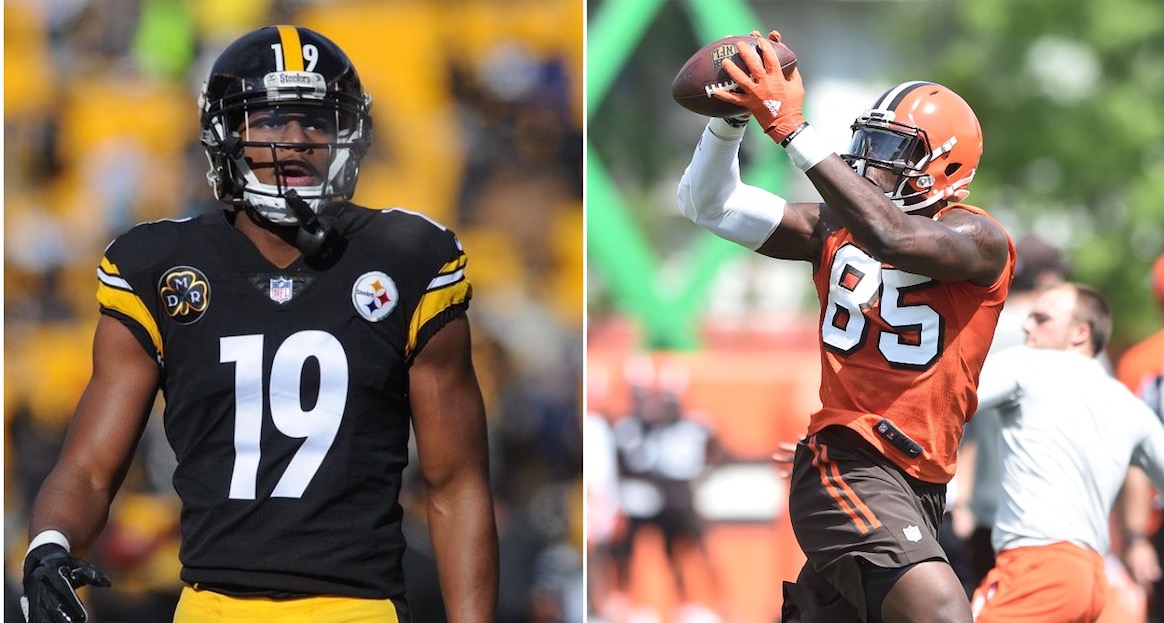
Fitz on Fantasy: The WRs and TEs You Need to Target
Yesterday I discussed some of the quarterbacks and running backs I’m targeting in this year’s fantasy drafts. Let’s move on to the wide receivers and tight ends.
Cost matters, obviously, which is why this isn’t just a list of top players. You don’t need me to tell you that Antonio Brown and Rob Gronkowski are good. This is about guys I especially like for the price. The ADP information provided here (that’s “average draft position” for any newbies in the audience) is courtesy of FantasyPros.com.
WIDE RECEIVERS
A.J. Green, Bengals (WR7) Green is being taken 20th overall, in the back half of the first round. He’s hardly a steal at that price, but I like the value, and Green will slip into the third round in some leagues after “merely” catching 75 passes for 1,078 yards and eight touchdowns last year. He’s finished as a WR1 in fantasy points per game every year since entering the league in 2011.
In touting Andy Dalton as a late-round value yesterday, I borrowed a stat from Fantasy Insiders’ Ben Gretch (@YardsPerGretch), who noted that Cincinnati ran a league-low 927 offensive plays last year after running more than 1,000 in each of the previous eight seasons. In other words, the Bengals had more than a full game’s worth of offensive snaps (and offensive stats) disappear into the ether. That’s one of the reasons that so many Bengals are on sale in fantasy drafts this year. Green isn’t marked down that much, but I’ll gladly take a 5% discount on a proven commodity.
JuJu Smith-Schuster, Steelers (WR17) Twelve days after turning 21, JuJu became a made man in the Steelers’ locker room by laying out Bengals LB Vontaze Burfict with a vicious block that drew a one-game suspension. Burfict had been an archvillain in Pittsburgh ever since he dealt out a head shot to Antonio Brown in a January 2016 playoff game, and even though Smith-Schuster’s nasty blindside block was exactly the sort of thing the NFL is trying to root out of the game, it made him a don in the Steel City nonetheless.
Smith-Schuster is a savage competitor who looks like he’ll be a perennial 1,000-yard receiver for the Steelers a la Hines Ward, but some fantasy owners will shy away due to the presence of Brown, the best receiver in football. But JuJu has enough moxie to return WR2 value on just 110-120 targets, and if anything were to happen to Brown, Smith-Schuster would become one of the most valuable fantasy assets at the position.
Allen Robinson, Bears (WR21) I see him as a low-end WR1 or high-end WR2; the market sees him as a back-end WR2. Ron Shandler, one of the foremost fantasy baseball analysts (yes, baseball), has said that once a player shows a skill, he owns it. I think we can apply that principle to football as well. A-Rob owns that 80-catch, 1,400-yard, 14-TD performance from 2015.
No, he didn’t play as well in 2016 while trying to haul in errant throws from Blake Bortles. Then Robinson tore his ACL in the 2017 season opener. He’ll have had a full calendar year to recover by the time the season begins, and he’s poised to become the alpha pass catcher in an opened-up offense helmed by Andy Reid disciple Matt Nagy and former Oregon Ducks schemer Mark Helfrich. I know A-Rob’s 2015 season seems like it was a long time ago, but I think it’s more plausible that Robinson recaptures his 2015 glory than it is that Josh Gordon recaptures the magic of 2013.
Chris Hogan, Patriots (WR26) There’s no way Hogan would be going this late if he hadn’t hurt his shoulder and missed seven games last season. He had five TD catches in his first five games of 2016 and was on a 976-yard pace over the first half of the season before going on the shelf. After coming back, he had two TD catches in three playoff games and went off in the Super Bowl, catching six balls for 128 yards and a touchdown. And while Julian Edelman serves a four-game suspension to start the season, Hogan could get some serious early-season target volume.
Emmanuel Sanders, Broncos (WR36) Sanders finished WR6, WR14 and WR 21 in his first three seasons with the Broncos before tumbling to WR61 last year. He missed four games, played much of the season a bad ankle and dealt with lousy quarterbacking. Sanders is healthy again, and Denver has stabilized the QB position with Case Keenum, Oh, and as Rotoworld’s Evan Silva pointed out on Twitter the other day, Sanders has been lining up in the slot more often during the preseason – a usage trend that bodes well for 2018.
Randall Cobb, Packers (WR39) Cobb hasn’t been a particularly valuable commodity since 2014, when he had 91 catches for 1,287 yards and 12 TDs, averaging more fantasy points per game than A.J. Green and Mike Evans. He’s since dealt with hamstring and ankle issues, and his yardage per catch has plummeted, bottoming out (I think) at 9.9 last season.
But this is all about opportunity. Davante Adams is the clear No. 1 receiver in Green Bay, and Jimmy Graham will be prominently involved, but there’s room for a third pass catcher to eat greedily from Aaron Rodgers’ trough, and Cobb is by far the best of the Packers’ other WR options. He has a good chance to get back to the 1,000-yard threshold if he can stay healthy.
Kenny Stills, Dolphins (WR48) The Devante Parker dream is basically dead. The first-round pick from 2015 has been a three-year tease and was reportedly having a poor training camp before breaking his finger. He’ll play this year, but it seems unlikely he’ll ever develop into the high-volume stud the Dolphins had hoped he’d become. Parker’s failure to launch opens the door for Stills to see the most substantial target volume of his career.
Over his first four seasons in the league, Stills averaged 16.7 yards per catch while maintaining a 58.6 catch rate, which is damn impressive efficiency. Last year he saw a career-high 105 targets and turned in a 58-847-6 stat line, which merits respect when you consider that Stills had Jay Cutler as his quarterback. It’s not hard to envision Stills leading the Dolphins in targets this year and posting career-best numbers.
Tyrell Williams, Chargers (WR66) Williams had a 1,000-yard season in 2016, but with Keenan Allen healthy and dominating targets last year, Williams slipped to 43 catches for 728 yards and four touchdowns – and that was with first-round pick Mike Williams either injured or ineffective in his first season. But Tyrell is 6-foot-3, he’s fast, he’s athletic, he has a big catch radius, and he’s bound to see at least some of the target spillover from the season-ending injury to TE Hunter Henry.
Tyrell’s floor is probably about what he did last year, and 728 yards isn’t bad for the 66th receiver off the board. As for the upside … I’m not going to say that Allen is injury-prone, but, well, he’s been hurt a lot. And because Allen is targeted so often and works the middle of the field so much, he’s in the line of fire quite a bit. We still don’t know what Mike Williams is going to be at the NFL level. So, Tyrell has that solid floor, and if Allen gets hurt again or is Mike Williams doesn’t pan out, Tyrell could see a huge spike in usage and return a massive profit on a late-round investment.
Mike Wallace, Eagles (WR82) I’m old and grumpy now, but I’m still a little boy at heart, and I like to pretend that I’m casting an invisibility spell on Wallace in every draft I’m in, because it seems like no one can see him but me. I mean, look at that ADP. Wallace’s theme music should be “How to Disappear Completely” by Radiohead.
During his two seasons in Baltimore, Wallace put up respectable numbers in a mediocre offense and showed he still has vertical skills. Now he’s positioned to play heavy snaps in a much better offense, and Wallace could play a big role early on if Alshon Jeffery’s slow-to-heal shoulder keeps him out the first few weeks of the season.
Taywan Taylor, Titans (WR97) This criminally low ADP is destined to climb after Taylor’s two-TD performance against the Buccaneers in the Titans’ second preseason game. He showed big-time jets on the first of those touchdowns, a 47-yard catch-and-run. Taylor is slated play in three-receiver sets along with Corey Davis, who may or may not be good, and Rishard Matthews, who’s been out with some sort of mysterious injury. The Titans’ offense should be better and more wide open with offensive coordinator Matt LaFleur scrapping “Exotic Smashmouth.” Taylor is a terrific late-round pick.
TIGHT ENDS
Delanie Walker, Titans (TE8) Rob Gronkowski is expensive in drafts. Travis Kelce’s target load could take a hit with a new quarterback and the Chiefs’ addition of Sammy Watkins. Zach Ertz seems a bit overpriced. If you’re skipping the first tier of tight ends and shopping the second-tier guys, Walker stands out as a bargain. He’s topped 800 yards in four consecutive years, but he’s averaged only five TD catches a season over that span, which has helped keep him affordable. If Corey Davis is a breakout star in 2018, Walker’s streak of 800-yard seasons will probably end. That’s a risk I’m willing to take. Walker was the eighth tight end off the board in my Scott Fish Bowl draft, and I was thrilled with the value, particularly with the TE-premium scoring format.
David Njoku, Browns (TE12) Check out this athletic profile. Would you be interested in something like that? Have you seen Njoku on “Hard Knocks”? He looks like he was sculpted by Auguste Rodin.
Rookie tight ends rarely do much, and Njoku wasn’t an exception last year, but I’m still encouraged that he caught 32 balls and scored four touchdowns for an empty husk of an offense that ranked 24th in yardage and 32nd in points. Pessimists will say that WRs Jarvis Landry and Josh Gordon will squeeze Njoku for targets. Maybe, maybe not. With this sort of athleticism at an affordable price, I’ll take my chances and hit the waiver wire if things don’t work out.
Ricky Seals-Jones, Cardinals (TE23) I was slow to buy in, but I’m on board now, especially after seeing the converted wide receiver throw a couple of hellacious blocks in the preseason. The Cardinals don’t have much firepower at wide receiver beyond Larry Fitzgerald, and Seals-Jones is probably a more dangerous vertical threat than Fitz is at this point. Seals-Jones has a light résumé, but his 12 catches produced 201 yards and three touchdowns last season, which should at least raise eyebrows. At this price point, he’s worth a shot in the late rounds of larger leagues.
Ben Watson, Saints (TE24) The last time Ben Watson and Drew Brees were together, Watson had 74 catches for 825 yards and six TDs, finishing TE7. That was three years ago, Watson has endured a torn Achilles’ since then and is now 37. But he still managed 61 catches for 522 yards and four TDs last year for the Ravens, and a return to New Orleans could help Watson squeeze out back-end TE1 value in the twilight of his career.



